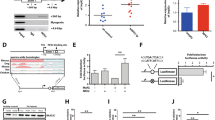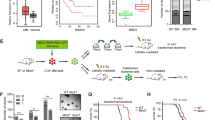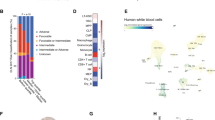Abstract
Abnormal activation of SETBP1 through overexpression or missense mutations is highly recurrent in various myeloid malignancies; however, it is unclear whether such activation alone is able to induce leukemia development. Here we show that Setbp1 overexpression in mouse bone marrow progenitors through retroviral transduction is capable of initiating leukemia development in irradiated recipient mice. Before leukemic transformation, Setbp1 overexpression significantly enhances the self-renewal of hematopoietic stem cells (HSCs) and expands granulocyte macrophage progenitors (GMPs). Interestingly, Setbp1 overexpression also causes transcriptional repression of critical hematopoiesis regulator gene Runx1 and this effect is crucial for Setbp1-induced transformation. Runx1 repression is induced by Setbp1-mediated recruitment of a nucleosome remodeling deacetylase (NuRD) complex to Runx1 promoters and can be reversed by treatment with histone deacetylase (HDAC) inhibitors Entinostat and Vorinostat. Moreover, treatment with these inhibitors caused efficient differentiation of Setbp1 activation-induced leukemia cells in vitro, and significantly extended the survival of mice transplanted with such leukemias, suggesting that HDAC inhibition could be an effective strategy for treating myeloid malignancies with SETBP1 activation.
This is a preview of subscription content, access via your institution
Access options
Subscribe to this journal
Receive 12 print issues and online access
$259.00 per year
only $21.58 per issue
Buy this article
- Purchase on Springer Link
- Instant access to full article PDF
Prices may be subject to local taxes which are calculated during checkout






Similar content being viewed by others
References
Minakuchi M, Kakazu N, Gorrin-Rivas MJ, Abe T, Copeland TD, Ueda K et al. Identification and characterization of SEB, a novel protein that binds to the acute undifferentiated leukemia-associated protein SET. Eur J Biochem 2001; 268: 1340–1351.
Cristobal I, Blanco FJ, Garcia-Orti L, Marcotegui N, Vicente C, Rifon J et al. SETBP1 overexpression is a novel leukemogenic mechanism that predicts adverse outcome in elderly patients with acute myeloid leukemia. Blood 2010; 115: 615–625.
Piazza R, Valletta S, Winkelmann N, Redaelli S, Spinelli R, Pirola A et al. Recurrent SETBP1 mutations in atypical chronic myeloid leukemia. Nat Genet 2013; 45: 18–24.
Makishima H, Yoshida K, Nguyen N, Przychodzen B, Sanada M, Okuno Y et al. Somatic SETBP1 mutations in myeloid malignancies. Nat Genet 2013; 45: 942–946.
Maxson JE, Gotlib J, Pollyea DA, Fleischman AG, Agarwal A, Eide CA et al. Oncogenic CSF3R mutations in chronic neutrophilic leukemia and atypical CML. N Engl J Med 2013; 368: 1781–1790.
Pardanani A, Lasho TL, Laborde RR, Elliott M, Hanson CA, Knudson RA et al. CSF3R T618I is a highly prevalent and specific mutation in chronic neutrophilic leukemia. Leukemia 2013; 27: 1870–1873.
Sakaguchi H, Okuno Y, Muramatsu H, Yoshida K, Shiraishi Y, Takahashi M et al. Exome sequencing identifies secondary mutations of SETBP1 and JAK3 in juvenile myelomonocytic leukemia. Nat Genet 2013; 45: 937–941.
Oakley K, Han Y, Vishwakarma BA, Chu S, Bhatia R, Gudmundsson KO et al. Setbp1 promotes the self-renewal of murine myeloid progenitors via activation of Hoxa9 and Hoxa10. Blood 2012; 119: 6099–6108.
Ott MG, Schmidt M, Schwarzwaelder K, Stein S, Siler U, Koehl U et al. Correction of X-linked chronic granulomatous disease by gene therapy, augmented by insertional activation of MDS1-EVI1, PRDM16 or SETBP1. Nat Med 2006; 12: 401–409.
Kouzarides T . Chromatin modifications and their function. Cell 2007; 128: 693–705.
Gelmetti V, Zhang J, Fanelli M, Minucci S, Pelicci PG, Lazar MA . Aberrant recruitment of the nuclear receptor corepressor-histone deacetylase complex by the acute myeloid leukemia fusion partner ETO. Mol Cell Biol 1998; 18: 7185–7191.
Lutterbach B, Westendorf JJ, Linggi B, Patten A, Moniwa M, Davie JR et al. ETO, a target of t(8;21) in acute leukemia, interacts with the N-CoR and mSin3 corepressors. Mol Cell Biol 1998; 18: 7176–7184.
Wang J, Hoshino T, Redner RL, Kajigaya S, Liu JM . ETO, fusion partner in t(8;21) acute myeloid leukemia, represses transcription by interaction with the human N-CoR/mSin3/HDAC1 complex. Proc Natl Acad Sci USA 1998; 95: 10860–10865.
Villa R, Morey L, Raker VA, Buschbeck M, Gutierrez A, De Santis F et al. The methyl-CpG binding protein MBD1 is required for PML-RARalpha function. Proc Natl Acad Sci USA 2006; 103: 1400–1405.
Morey L, Brenner C, Fazi F, Villa R, Gutierrez A, Buschbeck M et al. MBD3, a component of the NuRD complex, facilitates chromatin alteration and deposition of epigenetic marks. Mol Cell Biol 2008; 28: 5912–5923.
Bourachot B, Yaniv M, Muchardt C . The activity of mammalian brm/SNF2alpha is dependent on a high-mobility-group protein I/Y-like DNA binding domain. Mol Cell Biol 1999; 19: 3931–3939.
Cairns BR, Schlichter A, Erdjument-Bromage H, Tempst P, Kornberg RD, Winston F . Two functionally distinct forms of the RSC nucleosome-remodeling complex, containing essential AT hook, BAH, and bromodomains. Mol Cell 1999; 4: 715–723.
Xiao H, Sandaltzopoulos R, Wang HM, Hamiche A, Ranallo R, Lee KM et al. Dual functions of largest NURF subunit NURF301 in nucleosome sliding and transcription factor interactions. Mol Cell 2001; 8: 531–543.
Jiang H, Zhang F, Kurosu T, Peterlin BM . Runx1 binds positive transcription elongation factor b and represses transcriptional elongation by RNA polymerase II: possible mechanism of CD4 silencing. Mol Cell Biol 2005; 25: 10675–10683.
Du Y, Spence SE, Jenkins NA, Copeland NG . Cooperating cancer-gene identification through oncogenic-retrovirus-induced insertional mutagenesis. Blood 2005; 106: 2498–2505.
Li M, Riddle SR, Frid MG, El Kasmi KC, McKinsey TA, Sokol RJ et al. Emergence of fibroblasts with a proinflammatory epigenetically altered phenotype in severe hypoxic pulmonary hypertension. J Immunol 2011; 187: 2711–2722.
Larsson P, Ulfhammer E, Magnusson M, Bergh N, Lunke S, El-Osta A et al. Role of histone acetylation in the stimulatory effect of valproic acid on vascular endothelial tissue-type plasminogen activator expression. PLoS One 2012; 7: e31573.
Bee T, Liddiard K, Swiers G, Bickley SR, Vink CS, Jarratt A et al. Alternative Runx1 promoter usage in mouse developmental hematopoiesis. Blood Cells Mol Dis 2009; 43: 35–42.
Hayakawa T, Nakayama J . Physiological roles of class I HDAC complex and histone demethylase. J Biomed Biotechnol 2011; 2011: 129383.
Bots M, Verbrugge I, Martin BP, Salmon JM, Ghisi M, Baker A et al. Differentiation therapy for the treatment of t(8;21) acute myeloid leukemia using histone deacetylase inhibitors. Blood 2014; 123: 1341–1352.
He LZ, Tolentino T, Grayson P, Zhong S, Warrell RP Jr., Rifkind RA et al. Histone deacetylase inhibitors induce remission in transgenic models of therapy-resistant acute promyelocytic leukemia. J Clin Invest 2001; 108: 1321–1330.
Ramsey JM, Kettyle LM, Sharpe DJ, Mulgrew NM, Dickson GJ, Bijl JJ et al. Entinostat prevents leukemia maintenance in a collaborating oncogene-dependent model of cytogenetically normal acute myeloid leukemia. Stem Cells 2013; 31: 1434–1445.
Inoue D, Kitaura J, Matsui H, Hou HA, Chou WC, Nagamachi A et al. SETBP1 mutations drive leukemic transformation in ASXL1-mutated MDS. Leukemia 2015; 29: 847–857.
Okuda T, van Deursen J, Hiebert SW, Grosveld G, Downing JR . AML1, the target of multiple chromosomal translocations in human leukemia, is essential for normal fetal liver hematopoiesis. Cell 1996; 84: 321–330.
Wang Q, Stacy T, Binder M, Marin-Padilla M, Sharpe AH, Speck NA . Disruption of the Cbfa2 gene causes necrosis and hemorrhaging in the central nervous system and blocks definitive hematopoiesis. Proc Natl Acad Sci USA 1996; 93: 3444–3449.
Ichikawa M, Asai T, Saito T, Seo S, Yamazaki I, Yamagata T et al. AML-1 is required for megakaryocytic maturation and lymphocytic differentiation, but not for maintenance of hematopoietic stem cells in adult hematopoiesis. Nat Med 2004; 10: 299–304.
Growney JD, Shigematsu H, Li Z, Lee BH, Adelsperger J, Rowan R et al. Loss of Runx1 perturbs adult hematopoiesis and is associated with a myeloproliferative phenotype. Blood 2005; 106: 494–504.
Jacob B, Osato M, Yamashita N, Wang CQ, Taniuchi I, Littman DR et al. Stem cell exhaustion due to Runx1 deficiency is prevented by Evi5 activation in leukemogenesis. Blood 2010; 115: 1610–1620.
Huang G, Zhang P, Hirai H, Elf S, Yan X, Chen Z et al. PU.1 is a major downstream target of AML1 (RUNX1) in adult mouse hematopoiesis. Nat Genet 2008; 40: 51–60.
Olsen EA, Kim YH, Kuzel TM, Pacheco TR, Foss FM, Parker S et al. Phase IIb multicenter trial of vorinostat in patients with persistent, progressive, or treatment refractory cutaneous T-cell lymphoma. J Clin Oncol 2007; 25: 3109–3115.
Duvic M, Talpur R, Ni X, Zhang C, Hazarika P, Kelly C et al. Phase 2 trial of oral vorinostat (suberoylanilide hydroxamic acid, SAHA) for refractory cutaneous T-cell lymphoma (CTCL). Blood 2007; 109: 31–39.
Piekarz RL, Frye R, Turner M, Wright JJ, Allen SL, Kirschbaum MH et al. Phase II multi-institutional trial of the histone deacetylase inhibitor romidepsin as monotherapy for patients with cutaneous T-cell lymphoma. J Clin Oncol 2009; 27: 5410–5417.
Acknowledgements
This work was supported by the National Institutes of Health (NIH) grants RO1CA143193 (YD) and RO1HL118281 (JPM), USUHS Pediatrics Grant QP86GI (YD) and USUHS Exploratory Grant R0863031 (YD).
Disclaimer
The views presented in this manuscript are those of the authors; no endorsement by the Uniformed Services University of the Health Sciences or the Department of Defense has been given or should be inferred.
Author information
Authors and Affiliations
Corresponding authors
Ethics declarations
Competing interests
The authors declare no conflict of interests.
Additional information
Supplementary Information accompanies this paper on the Leukemia website
Supplementary information
Rights and permissions
About this article
Cite this article
Vishwakarma, B., Nguyen, N., Makishima, H. et al. Runx1 repression by histone deacetylation is critical for Setbp1-induced mouse myeloid leukemia development. Leukemia 30, 200–208 (2016). https://doi.org/10.1038/leu.2015.200
Received:
Revised:
Accepted:
Published:
Issue Date:
DOI: https://doi.org/10.1038/leu.2015.200
This article is cited by
-
Impaired neurogenesis and neural progenitor fate choice in a human stem cell model of SETBP1 disorder
Molecular Autism (2023)
-
SETBP1 is dispensable for normal and malignant hematopoiesis
Leukemia (2023)
-
Inhibition of EZH2 by chidamide exerts antileukemia activity and increases chemosensitivity through Smo/Gli-1 pathway in acute myeloid leukemia
Journal of Translational Medicine (2021)
-
Mutant SETBP1 enhances NRAS-driven MAPK pathway activation to promote aggressive leukemia
Leukemia (2021)
-
ZNF326 promotes malignant phenotype of glioma by up-regulating HDAC7 expression and activating Wnt pathway
Journal of Experimental & Clinical Cancer Research (2019)



